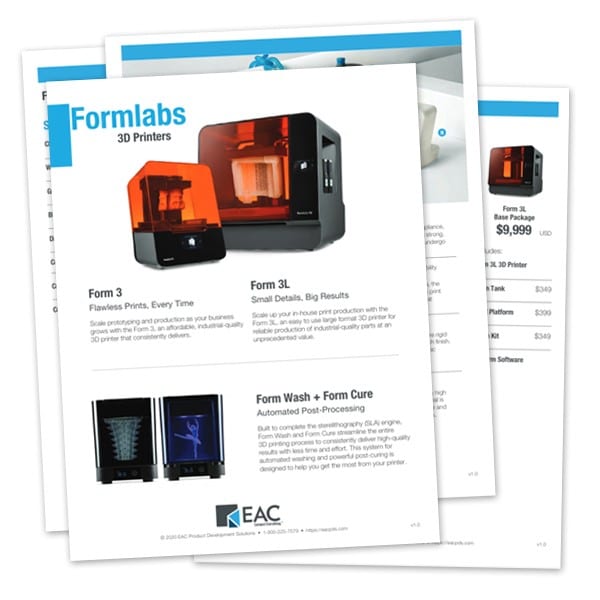The next generation of Stereolithography (SLA) 3D printing is here… and we’re here to tell you about it!
Formlabs introduced two new printers, the Form 3 and the Form 3L, using a process called Low Force Stereolithography (LFS) to bring you advanced 3D prints. This new additive manufacturing technology gives you the ability to create better and more affordable parts and enables production-ready applications with higher production volumes.
Let’s get down to the basics.
What is stereolithography (SLA) 3D printing?
The SLA 3D printing process is known for creating a smooth surface finish and detail using a laser to cure solid isotropic parts of liquid photopolymer resin. The Form 2 SLA 3D printer process allows for lower production costs to manufacturers than most 3D printing industrial machines and it leaves a smaller footprint by using less material.
What is Low Force Stereolithography (LFS)?
Low Force Stereolithography (LFS) is an advanced form of SLA printing that uses a flexible tank and linear illumination to turn liquid resin into flawless parts. LFS technology produces all the benefits of SLA technology plus the following features:
- A clean laser spot via a spatial filter ensuring high precision and accuracy
- A parabolic mirror creating a perpendicular laser spot for uniformity across the build platform
- Soft release from a flexible tank enabling easy cleanup by requiring small, minimal supporting
- High performing future materials
- User-replaceable LPU with garage mode to protect optics
- Adaptive print speed for perfect balance of speed and detail
- System scales for large format 3D prints
Low Force Flexible tanks work by the build platform pulling up the part and gently releasing it from the film. When you have a more flexible tank, you get lower force, which allows for better print quality and better printer reliability. Lower forces on the part lead to incredible detail and surface finish, easier support removal, and cutting-edge material possibilities.
The Components of LFS 3D Printing
Condensed optics module: A custom-designed Light Processing Unit (LPU) inside the printer uses a compact system of lenses and mirrors to deliver accurate, repeatable prints.
Flexible Tank: The bottom of the resin tank is a flexible surface that enables a massive reduction in peel forces while printing.
Linear Illumination: The high-powered laser from the LPU coupled with the parabolic mirror provide a crisp completely perpendicular curing source during the LFS 3D printing process.
The Benefits of LFS 3D Printing
- Pinpoint precision for flawless prints
- Balances high detail and high speed
- Faster printing with a high frequency galvanometer
- Many integrated sensors to monitor performance for reliable, nonstop printing
- Fine-touch support touch points
- Better printing for resins with higher viscosity and lower green strength
How linear illumination creates precision and uniformity with parts
Linear Illumination = Precision + Uniformity = Accurate, Repeatable Parts
One galvanometer positions the laser beam in the Y direction. The beam is then directed to a fold mirror and parabolic mirror so the beam is:
1) Always directed perpendicular to the build plane (uniformity/consistency)
2) Always moving in a straight line (precision/accuracy)
What is an LPU and why does it matter?
The LPU is one of the most revolutionary components of Formlabs’ LFS 3D printing technology. The Form 3 contains 1 LPU unit where the Form 3L contains 2.
The LPU holds the laser, the galvanometer, and a system of lenses and mirrors. The parabolic mirror maintains a perpendicular path to the bottom of the resin tank at all times, making for consistently clean, crisp edges and smooth surfaces.
The LPU is a single replaceable part located in the main printer body that folds almost every optical component of the printer into a small metal housing unit.
Rather than containing two galvanometers like the Form 1, Form 1+, and Form 2, the LPU contains just one galvanometer that controls the direction of the laser, as the entire LPU unit moves across the build area.
The main four components of an LPU galvanometer are the fold mirror, the laser, the parabolic mirror, and the galvanometer.




Features of a Light Processing Unit (LPU)
- Highly Precise, Consistent Laser
- Telecentric Laser Beam
- The laser beam in the LPU is always perpendicular and in constant focus at the print plane, thanks to the galvanometer and the parabolic mirror
- This results in the best possible print quality that is uniform, highly accurate, and consistent across the entire print plane
- Telecentric Laser Beam
- Custom high-power module
- Custom high-power-density laser module
- The laser has a spot size of 85 microns (40% smaller than the Form 2!) and a 25% higher power at the print plane due to the improvements in optical path efficiency in the LPU
- This multi-lens system with spatial filtering reduces stray light to sharpen edges even further and ensure consistent, pinpoint precision which creates smoother surfaces and high dimensional accuracy on printed parts
- Custom high-power-density laser module
- Custom high-frequency galvanometer
- The custom galvanometer combined with other features (like adaptive print speed and not needing to use the mixer between layers) allows for fast print times and consistent quality
- Modular and scalable
- Bigger prints (at an affordable price) designed to scale. For the Form 3L, two of the same modules are used as the Form 3
- Self-diagnostics
- Reliability: Constant sensing and automatic calibration
- Field replaceability
- Uptime: No need to swap out your printer to replace the laser or other key optical components
Now that you know how Low Force Stereolithography works, you’re better informed on how you can use Formlabs’ new 3D printers, the Form 3 and the Form 3L.
Reach out if you have any questions, and don’t forget to follow me on LinkedIn to check out my tips and tricks on how to use Formlabs 3D printers and trends in the additive manufacturing industry!
